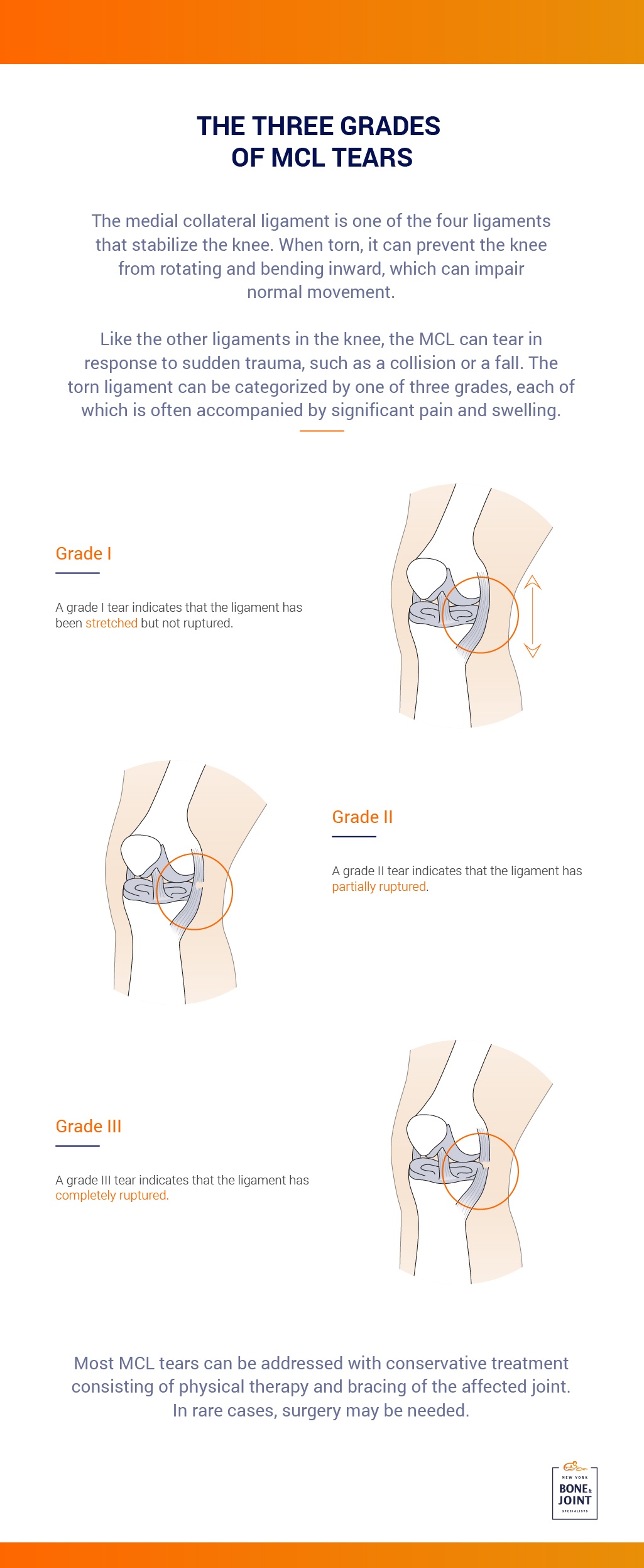WHAT IS THE MCL?
The medial collateral ligament, usually referred to simply as the MCL, is one of four ligaments that stabilize the knee. Located along the inner knee, it enables the knee to rotate and prevents it from bending inward. Like other ligaments in the knee, the MCL is quite susceptible to sprains and ruptures, easily tearing in response to sudden trauma.
MCL TEAR GRADES AND SYMPTOMS
Not sure what type of treatment to pursue for your MCL tear? The first step is determining the extent of your injury. MCL tears can be classified as grade 1, 2, or 3: a grade 1 tear indicates that the ligament has been stretched but not ruptured. A grade 2 tear designates a slightly more severe, but still partially ruptured ligament. In contrast, a grade 3 tear indicates a completely torn ligament.
The symptoms of an MCL tear depend on the severity of the tear, with grade 1 tears usually resulting in less pronounced symptoms. Most patients, however, experience sharp pain and significant swelling along the inner knee. Other common symptoms include:
- Stiffness, tenderness, and a sense of instability in the affected knee
- A limited range of motion, particularly when moving laterally
- A locking or catching sensation when walking
MCL TEAR TREATMENTS
Treatment for MCL tears varies with the severity of the condition, but in most cases, symptoms resolve with a few simple conservative measures. Surgery is usually necessary only if the patient has sustained significant structural damage.
Conservative
Conservative treatments for MCL tears, especially grade 1 or 2 tears, are largely centered around rest and rehabilitation. Some of the most common include:
- Resting and icing the knee
- Keeping the knee elevated
- Taking anti-inflammatory medications
- Walking with crutches
- Wearing a hinged brace
- Performing stretching and strengthening exercises designed to restore the knee’s range of motion and redevelop the surrounding muscles
Surgery
Though usually unnecessary, a torn MCL can also be repaired surgically. Surgery tends to be necessary if the ligament fails to heal with conservative treatments or other ligament tears are destabilizing it. Depending on the site of the injury, your surgeon may mend the tear or reattach the ligament to the bone with stitches and a bioabsorbable anchor.
MCL TEAR RECOVERY AND RECOVERY TIME
Most patients recover quite quickly from torn MCLs after receiving conservative treatment. You can expect a complete recovery (including the ability to play sports without restriction) after four to six weeks of rest and physical therapy.
Unlike other conditions commonly treated with surgery, a surgically repaired MCL can recover as quickly as an MCL treated with conservative measures. In the days after surgery, all patients will need to regularly ice the treated knee, walk with crutches, and wear a supportive brace. Physical therapy can begin within a week or two, and complete recovery should follow after six to eight weeks of rest and rehabilitation.











